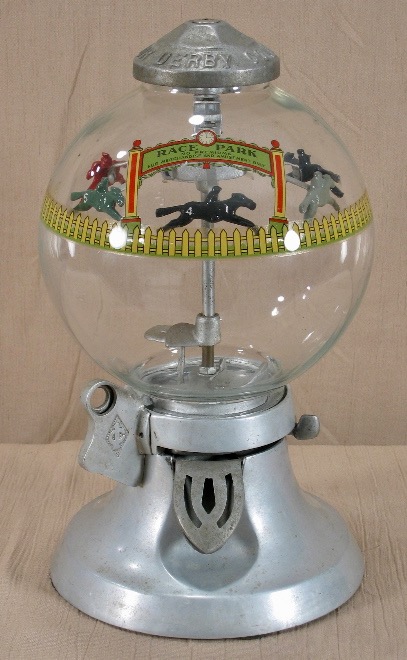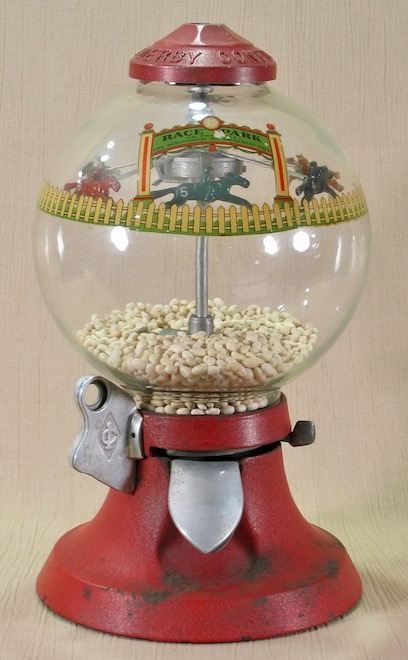___________________________________________________________________________________________
Simpson Derby Confection Vendor


___________________________________________________________________________________________


R. D. Simpson Co., Columbus, OH, c. 1940, 15 1/2". This is a combination game and vendor---almost a trade stimulator, but I don't collect trade stimulators so it must be a vendor, right? Proof-positive evidence for that lies in the name: Derby Confection Vendor, not Derby Confection Trade Stimulator or Derby Confection Counter Game. Trade-stim guys might like this model, but it belongs in a vending guy's hands.
The way it works is this: You put a penny into the slot, pull the lever all the way forward and to the left (which dispenses the goods into the chute), and then let the lever go. It springs back to the right and slams against the body, which always scares the hell out of me---each time I do it I half-expect the lever to snap off and continue its rearward trajectory. I flinch every time I run a penny through, so I don't run many. The backward momentum of the vending wheel after it's released causes the horsies to circle left to right until one stops in the winner's circle. The decal promises no prize for guessing which horse will do that, and indicates clearly that this is for "amusement only," so I'm sure no one ever bet on which horse would win the next race.
This model is a pain in the ass to work with. To change the globe you need to remove the horsies or loosen them and push them together so the globe can pass over them. If you do that, then be extra-careful to not scratch the decal. In addition, the mechanism is tempermental and if it's not adjusted just right then the horsies won't turn smoothly or won't stop where they should. I don't know the sales history of this model, but I wouldn't be surprised if sales were good for first orders and then fell sharply for reorders. Once vendors learned how ill-designed this was for real-life usage, I'd imagine that most decided it was more hassle than it was worth. This is not a rare machine but it's uncommon, and that could be the reason.
I know of three versions of this model, which I think (but don't know for sure) appeared chronologically:
This version was available in a gum or bulk version, with the gum version being considerably scarcer than the bulk version even though the only difference between them is a gumball adapter that attached to the normal bulk vending wheel.
The mechanism on this earliest version is also different, which in my opinion is what sets it apart from the version pictured above right. Instead of a notched aluminum piece stopping the horses, a magnet was used to slow and then eventually stop them. I've seen this version in action only once, and the horses spun more smoothly and without the clackety-clack of the later versions.
I tend to think of this earliest version as scarcer than the other cast iron version, but after I bought the one above at the November 2022 Chicagoland show, I overheard some friends talking about it and their comments suggested that both are about equally available and are much scarcer than the aluminum version. I was offered one of these earliest versions a looong time ago on a Friday morning in the parking lot of the Chicagoland show. I passed because I thought it was overpriced and I figured another one would come along later at a better price. I still think it was overpriced but the guy sold it in short order after that and so far my "later" hasn't come, so what do I know? Comparing the two cast iron versions, I like the detail on the embossed aluminum lid of the one pictured above but like the magnets on the earliest one, and marquees are always good.
Two more comments about the aluminum version:
Note that the lid and gate have darkened more than the other pieces have. I've seen that phenomenon on other aluminum vendors that I knew had not been fiddle-futzed with, so when you see it it doesn't necessarily mean that a collector has swapped parts around. I guess it could mean that a vendor swapped parts years ago, but if so then it happened before the first collector got hold of it and in my opinion doesn't degrade from the machine's desirability.
___________________________________________________________________________________________
___________________________________________________________________________________________
©Small Vintage Vending 2022